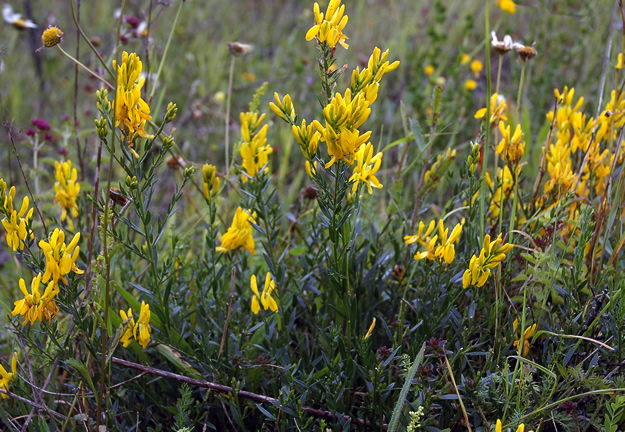
Woody > Genista > Genista tinctoria > Genista tinctoria
Genista tinctoria
Dyer's Broom, Dyer’s Greenweed
Origin: Introduced into cultivation in 1789 from east Asia.
Mike's
Opinion


"
A plant tolerant of harsh dry conditions once established, however it is somewhat promiscuous and can become a problem in areas where conditions are ideal; thus use with caution. Enjoy its flamboyant flush of blooms in late spring.
Michael Pascoe, NDP., ODH., CLT., MSc. (Plant Conservation)
"
| Family |
| Fabaceae |
| Genus |
| Genista |
| Species |
| tinctoria |
| Category |
| Woody |
| Type |
| Shrub (deciduous) |
| Pronunciation |
| USDA Hardiness Zone |
| 4-7 |
| Canadian Hardiness Zone |
| 2 |
| RHS Hardiness Zone |
| H7 |
| Temperature (°C) |
| - 45 |
| Height |
| 0.5-1 m |
| Spread |
| 0.5-1 m |
Photographs
Description and Growing Information
Flowering Period
| General Description |
| A low lying deciduous shrub that usually grows just under a meter high and has about a meter spread. The main stem portions of the plant are bright green and smooth in texture. It has masses of bright yellow flowers arranged alternately along the stems, enveloping the entire plant. |
| Landscape |
| It may be used as an individual or mass planting in the landscape. Caution needs to be exercised in its use, as under ideal conditions it can become an invasive, problematic species. |
| Cultivation |
| It prefers a sunny location and thrives on poor soils such as sand, gravel, and limestone. It does not transplant easily. |
| Shape |
| It is a low, sprawling, somewhat unkempt. shrub |
| Growth |
| Medium |
| ID Characteristic |
| It has many bright yellow flowers enveloping the entire plant when in bloom. It grows low to the ground usually reaching heights of less than one meter and when not in bloom is bright green in colour. |
| Pests |
| None serious. |
| Habitat |
| Found on well drained, sandy soils and can usually be seen growing alongside roads or fields or on limestone rock outcrops. |
| Bark/Stem Description |
| Bright green and smooth sometimes covered in little hairs ( trichomes ). |
| Leaf Description |
| Leaves are alternate along the main stems of the plant and have a pinnate venation, lanceolate, cuneate base, with an entire margin and an acute apice. |
| Flower Description |
| Bright yellow in colour, arranged along the stem in a raceme. |
| Fruit Description |
| The fruit is a 2–4 cm long pod, glabrous and contains 8-12 black, shiny, flat seeds. |
| Colour Description |
| Bright green bark through all seasons. Leaves are bright green with no notable autumn colour. The flowers, the outstanding feature of the plant are bright yellow and envelope the entire plant at peak bloom. |
| Texture Description |
| The plant is rather fine textured. |
| Propagation |
| The seeds have the highest chance of successfully germinating if they are given a thirty minute acid scarification followed by a water bath. Cuttings can also be taken from the plant in July, August or early September. They should be placed in a cold frame outside in sand and should root by the following spring. |
References
Dirr, Michael, Manual of Woody Landscape Plants. 6 ed. Champaign, Illinois: Stipes Publishing. 2009.

.jpg)